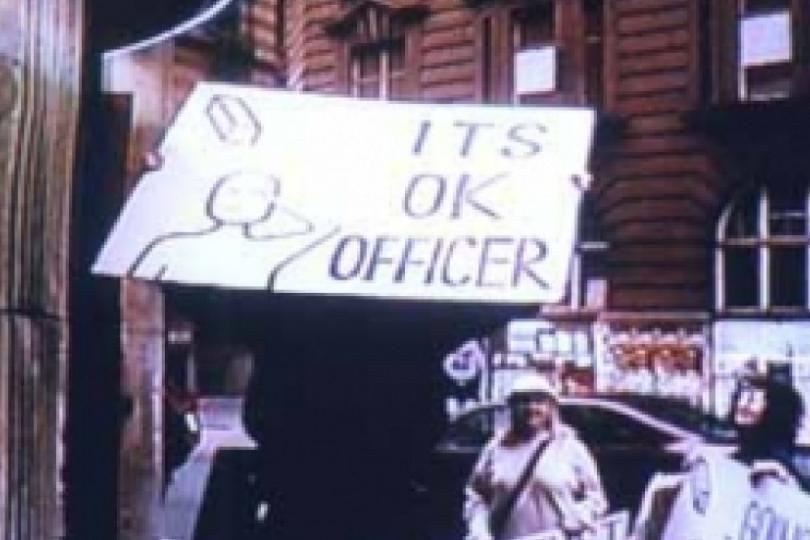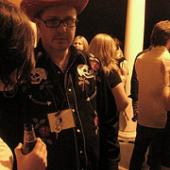There’s been a lot of talk lately about something called “pop-up theater,” or, since most of the talk seems to be taking place in the United Kingdom, “theatre.” The idea is pretty simple, and certainly not especially new: Instead of producing a play in an established theater venue, you instead produce it somewhere unexpected.
Often the chosen locations comment on the play. The Young Vic, for instance, did a play called “The Container” that dealt with refugees entering England on the back of a truck. The play was produced in an actual shipping container. But pop up theater doesn’t have to be so literal: Art darling Banksy debuted his documentary “Exit Through the Gift Shop” in a 150-seat theater, that was built in an unused tunnel under Waterloo Station, billed as London’s “darkest and dirtiest” theater.
One suspects this is because London is so darned expensive. Rather than deal with the cost of maintaining a year-round theater space, or even renting a theater space for a few months, performers are just grabbing whatever corner of London they can for the run of a show, setting up a makeshift lighting kit, and hightailing it out of there when things are done. And this is why I’d like to discuss the fad, although I should take a moment to point out its antecedents.
It's not especially new
This is similar, of course, to Off-Off-Broadway. In part for financial reasons, Off-Off-Broadway rejected New York’s established theater spaces in favor of churches, cafes, and other nontraditional venues. But Off-Off-Broadway quickly morphed into small black box spaces -- they developed their own sort of permanence, while pop-up theaters are intended to be short-lived. And pop-up is similar to site-specific work, except that site-specific work is typically, well, specific to the site being used. The work is built around the space, and may not make sense elsewhere.
Nonetheless, this is a trend that has a lot of history. Heck, back in 2001 or thereabouts, Skewed Visions produced a show at the Fringe called “The Car” that took place in an actual car, driven around the city. Our own Alan Berks helped create a series of short plays performed in area bars, and his last Fringe entry was produced in an art gallery. Off-Leash Area produced their play “A Gift from Planet BX63” at a series of garages last summer (I wrote the dialogue for that show), and Michael Sommers has actually built a traveling theater on the back of a bike just for the purpose of transporting shows to neighborhood venues. The Walker regularly brings performances that take place outside their theater. I think the name “pop up theater” appeared, not because it’s a new trend, but because there is so much of it all of a sudden.
Why it's worth talking about
But I think it’s especially worth considering now, especially in American theater. We suffer from a dearth of new productions nowadays, and the book “Outrageous Fortune” by Todd London and Ben Pesner identified a number of reasons for this, and one of them was the institutionalization of non-profit theater. A large number of small American theater companies maintain their own theater spaces, and, as a result, a large percentage of their budget goes into paying rent. Even without the space, there’s a great need to spend money to support the institution year-round, including paying salaries. And just as you cannot serve both God and Mammon, it’s quite difficult to make maintaining an institution a priority and produce financially risky new work. There’s a large disincentive, in fact, to experimenting. This doesn’t mean it’s impossible, of course -- new work does get produced, and a lot of it is quite risky. But the amount of this work that debuts every year is passingly small.
Pop-up theater offers an alternative financial model. If you do a play project-by-project, rather than maintaining a company year-round, and you see almost anyplace as a potential venue, you pare back on production costs dramatically. Even renting a theater space can be quite expensive -- you may not need to maintain it 12-months a year, but somebody has to, and they’re going to charge enough to cover that, as well as make a profit. But there are an endless number of cheaper rental spaces, and free spaces, in any city. Performer Ann Magnuson, in what may be one of the earliest examples of what we now think of as pop-up theater, took over the elevator in the Whitney and sang along with the elevator’s Muzak soundtrack for five continuous hours. I have my own example, which I’ll mention briefly: I have a play titled “Sleaze Book Club,” which is just that -- a group of actors get together and provide book reports for mid-20th century pornographic literature they have read. The last time I produced this, we simply requested a room at the Central Library downtown, telling them we were an actual book club. Which, in a way, we were. Total cost of the venue: $0.
Pop-up theater for playwrights -- and others
It’s especially useful for playwrights to think about writing for pop-up theater. We tend to write plays with the idea that they will be mounted on a traditional stage, but odds are against us on this -- most mid-level playwrights will only get half of what they write produced, and, even then, it will only enjoy one brief production. The solution to this, as playwright Mac Wellman likes to tell people, is to produce your own plays. But this is often economically unfeasible, as playwrights may not have the capital to rent spaces and lighting kits and seats and whatnot. Individual playwrights don’t have access to grants in the way institutions do, and they don’t tend to have their own non-profits, so they can’t solicit money the way institutions do.
But pop-up theater can bring the cost of a production down to a manageable level. And this is worth considering for anybody involved in making theater -- not just playwrights. Independent producers can potential do more or riskier work, and even performers can take the reigns in producing work that they are interested in, rather than waiting for a theater to put on a play that they are appropriate for.
Really, it’s just a matter of finding a location that is willing to serve as your venue -- and you’d be surprised how many places are available for free. Bars, for instance, are often willing to set aside a night for a performance, as it is to their benefit to get a certain number of people into their space to buy drinks. If you can find a nonprofit to act as an umbrella organization for your production, people are often willing to donate unused office spaces, or storefronts, or other commercial property, for the length of the run in order to be able to write off what they would have made in rental. Simple lights kits can easily -- and cheaply -- be rented from audio/visual businesses, often for under $200 per week, and under $100 for a weekend. Folding chairs can likewise be rented. And there you have it -- a theater space, for as long as the play lasts.
And there’s an even cheaper option, although it’s riskier: just take over a space, perform a play, and get the hell out. It’s what the underground rave scene used to do in Los Angeles, and it’s a very appealing option for a certain type of theater. There’s an especially odd group called the Surveillance Camera Players who would produce short scenes directly into security cameras. More famously, Improv Everywhere deliberately chooses unlikely and surprising locations for their performances, and don’t even let their audiences know that they are about to see a show. It will just start, in the middle of a Starbucks or subway station, and, a few minutes later, be done.
It’s been quite a long time since Shakespeare told us that all the world’s a stage. This is an especially good time to take him too literally.
Max Bunny Sparber
Max "Bunny" Sparber was the guest editor of MinnesotaPlaylist from December 2010 through February 2011, as well as being a longtime arts critic and playwright. His dramatic writing can be read at
http://www.maxsparberplays.com/.





